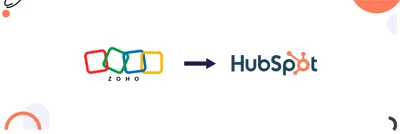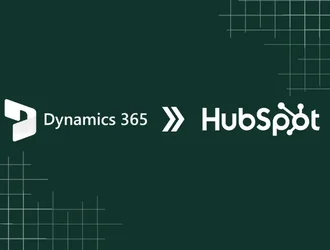A Comprehensive Guide to Zoho to HubSpot Migration
Learn the step-by-step process for planning, data transfer, and managing Zoho to HubSpot migration.

Discover the power of HubSpot's Predictive Lead Scoring tool to enhance lead management, improve marketing efficiency, and boost conversions.
Today, managing leads is one of the most significant factors that contribute to the overall success of any organization. Sales and marketing teams increasingly recognize the critical role of lead scoring in driving conversions.
This article aims to give an advanced examination of the concept called predictive lead scoring, its functions, features and advantages, and rules for applying this tool as a part of a complex picture in sales and marketing.
Predictive lead scoring is an analytical approach that involves classifying leads with the highest probabilities of conversion at the onset of the relationship marketing campaign. mIn contrast to previous lead scoring processes which were largely manual and thus often subjective and cumbersome, HubSpot’s predictive lead scoring uses sophisticated statistical analysis and machine-based learning to consider many parameters concerning possible customers.

Manual lead scoring often relies on set criteria, intuition, or simple demographic data, mostly on intuition or simple demographic facts scored by sales and marketing teams. This is not a defined pattern, and it will lead to conflict and errors as team members may interpret ‘high-quality lead’ differently.
.
Connected customers need only to subscribe to Sales Hub Professional or Enterprise plans to be able to access the predictive lead scoring tool. As with other HubSpot tools, it integrates with HubSpot CRM, evaluating and synthesizing hundreds of variables including the user's interactions, demography, and prior activities. This system also contains built-in machine learning mechanisms to analyze the data and provides the most likely risk score for each prospect from 1-100 without any external input.
The predictive scoring model takes into account several important elements, such as:
Behavioral signals: Any activity that involves email opened, links clicked, page visits, and downloads.
Demographic data: Factors such as a person’s job, field, size of the occasion, and location can be very useful for fitting into the ideal customer profile.
Historical data: The scoring model benefits from the tactics employed to convert leads from previous cases, including analyzing the successes of other consumers.
Here is why HubSpot predictive lead scoring is important.
Predictive lead scoring aims to identify leads with higher chances of converting, and this is one of its more important advantages. As a result of putting their efforts in these valuable leads, the business sales plans can be better and the efforts can be concentrated on the areas which require the most attention. This targeted strategy not only increases the conversion rates but also improves the efficiency of the whole sales process.

It is the capability to reach the targeted group of individuals that decides the success of marketing campaigns. With HubSpot’s predictive lead scoring, marketing team efforts can be directed to niche leads who are more likely to engage back.
Once tailored to these leads, businesses enhance their campaign's messaging, generate more engagement, and achieve more positive results. This helps in avoiding wastage of budgetary provisions because they can invest only in the prospects whose returns are most promising.

The growth of the company’s revenue requires a proper interaction between the marketing and sales teams. Thanks to HubSpot’s predictive lead scoring the understanding of what qualifies as a quality lead is more objective thus creating cohesion. If both teams agree on the traits of the leads with the highest chances of conversion, all parties will be able to maximize the effectiveness of sharing tactics and information.
-png.png?width=680&height=383&name=marketing%20(1)-png.png)
Time is known to be one of the assets that are very valuable for sales teams, and when predictive lead scoring is utilized, organizations can save valuable time on leads that are not worth pursuing. Automated lead scoring helps in hot rating leads, thus allowing sales professionals to dedicate their effort to relevant leads that are expected to respond and avail themselves in deals, thus improving efficiency.
-png.png?width=680&height=383&name=marketing%20(3)-png.png)
The benefit of predictive lead scoring goes beyond just enhanced lead prioritization within an organization. Here are some of its key advantages.
Accuracy regarding lead scoring is relatively higher in the predictive lead scoring model as it is data-driven. Since the system uses a statistical tool to evaluate many variables, HubSpot controls to a large level the potential of each one of the leads. This guarantees that no high quality leads to waste. And all poor leads are sorted out.
One of the main features of HubSpot’s predictive lead scoring feature is the fact that it is automatable. The marketing and sales teams do not have to engage in heavy manual entries and interpretations to a certain extent. This makes it easier for them to work on broad strategies such as building and fostering management with potential leads and marketing.
Since the sales team is concentrating on the high-converting leads, they can streamline their coverage strategies. Representative predictably lead scoring inhibits appropriate dispersion of time and resources within the sales team leading to better sales performance. If sales representatives target leads who are most likely going to be converted, they stand to make more sales and increase conversion rates.
Enhanced lead prioritization leads to maximize returns on marketing and sales investments. Businesses employing predictive lead scoring usually have a better return on investment (ROI) against marketing since they market only to those leads with a high probability of conversion. This in the end boosts the bottom line further.
HubSpot’s predictive lead scoring model can be adjusted according to the requirements of the business. By modifying scoring parameters according to the type of business and customer characteristics, firms can customize the scoring model to suit the sales processes they employ and the goals they set.
To maximize the benefits of HubSpot predictive lead scoring, it is necessary to follow the process in the following order:
HubSpot collects large data from the CRM to track the relationships and attributes of the lead collection. Data shows how the potential clients interact with the organization’s content and behavioral data that help to understand their actions. Constantly collecting such data and examining it enables HubSpot to develop a rich database that complements the predictive scoring model.
A multitude of factors come into play in the predictive lead scoring model, such as behavioral, demographic, and historical. Using the above granules of information, HubSpot can work on cross-evaluating the conversion potential of each lead.
The scoring details utilized in the scoring algorithm involve machine learning techniques and predictive indicators that ascribe lead scores to prospects. After setting up the model, every lead that is captured is allocated a score that ranges between 1 and 100. The higher the score, the higher the probability of conversion increases, thus providing sales teams with a clear hierarchy of sales calls that should be effective.
Ranged within the business management platform known as HubSpot, the customers can efficiently view and understand lead scores. This screen also presents information on the lead’s score and other associated activities performed by the lead and their engagement status. This level of visibility helps the sales and marketing departments in making decisions on the level of target leads and the methods of approach.
For maximum efficiency of the predictive lead scoring of HubSpot, these associated features should be added:
The predictive lead scoring model’s efficiency is impacted positively by the data that you input into the system crayon. Ensure that your CRM data has minimum redundant and stale data and that best practices of data entry compliance are undertaken. By protecting data quality, you also protect the efficacy of lead scoring.
-png.png?width=680&height=383&name=marketing%20(4)-png.png)
Modifications should also be done on the lead scoring parameters if they seek to achieve a certain set target. Personalizing the scoring pattern enables one to understand the features of the target audience and the kind of business they are operating in making lead scoring more relevant.

Predictive lead scoring works best when dimes another HubSpot tool such as workflows, email marketing, and nurturing campaigns. Employing these tools goes a long way in boosting how marketing is done hence ensuring that high-scoring leads are touched, and the lead-scoring process is not wasted.

Every lead score should be consistently validated to ensure it meets the established standards; if not, the criteria should be updated accordingly. Predictive lead scoring is born from data and it is therefore expected that at every point in time, the system is up to date without bugs and errors, and relevant given the turbulence that often exists in the marketplace.

Make sure that your sales teams comprehend and utilize the forecasting lead scores effectively for subsequent interactions and suits. Providing enough training and materials to your sales representative enables them to take advantage of what is referred to as predictive lead scoring, collaborating better, and performing better.

When it comes to efficient lead conversion, the use of HubSpot’s predictive lead scoring tool proves to be a valuable investment. A business can avoid wastage of time and human energies by incorporating predictive scoring into their sales and marketing endeavors and making sure that only those prospects who fit the profile are best to attend.
The three-dimensional implementation of HubSpot predictive lead scoring, i.e. using data analytics, machine learning, and team collaboration will go a long way towards achieving even better results in the sales process at any company.
In using this very useful tool, know when to use it, especially customizing the process, cleaning the data, and harnessing all teams to achieve the maximum return. Apply this revolutionary change to improve how your team manages leads and push the boundaries of what your company can achieve.

Learn the step-by-step process for planning, data transfer, and managing Zoho to HubSpot migration.

Step-by-step guide to migrating from Microsoft Dynamics to HubSpot. Learn tools, challenges, and tips for a smooth transition.

Make your HubSpot-to-HubSpot migration easy with this straightforward guide. Discover practical steps to plan, migrate data, and optimize.